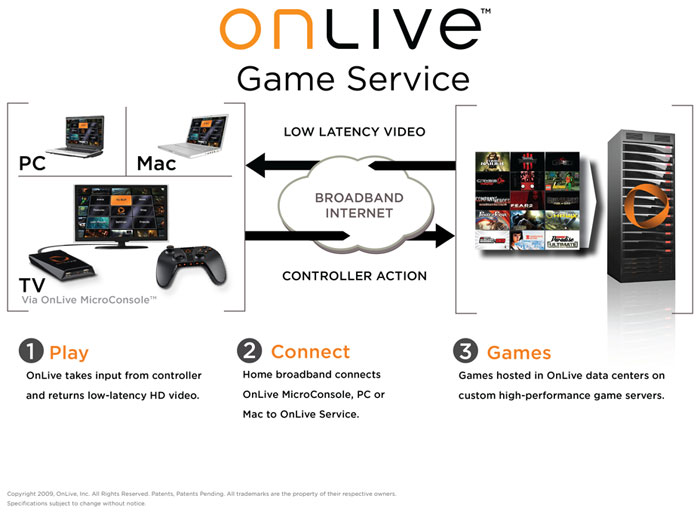http://arstechnica.com/gaming/news/2009 ... erence.ars
MIT is playing host to Technology Review's EmTech conference, which focuses on up-and-coming companies and the new technology they're bringing to market. Steve Perlman, the founder and CEO of the OnLive gaming service, was given the chance to demonstrate his company's cloud gaming service, and took some time to explain the technology backing it. OnLive is gaming's answer to cloud computing: the applications run on hardware in a server farm, while users only need low-end hardware (including OnLive's own mini-console) and broadband Internet to connect in and play. The service will have some limitations, however, and your experience may vary with network speed.
For starters, Perlman gave some indication of the network requirements for it. Anyone with a 1.5Mbps connection should be able to run the service at standard definition; 5Mbps will be required for HD content. Although bandwidth will be critical, low latency connections will be necessary to avoid hitting the user with perceptible lag. OnLive has found that the server has to be within about 1,000 miles of the end user in order to avoid this. As such, it will be launching the service with four server farms.
Another impressive tech demo
For the purposes of his demo, Perlman connected to a server farm in Virginia. MIT clearly has access to some pretty significant pipes, but the quality of the demos, which included some time showing off an arena in Crysis, was very impressive, given that it was running on a standard MacBook Pro. All sorts of environmental features, from bubbles generated while swimming to crabs scuttling along the beach, were fluid, and provided a very immersive experience. Perlman joked repeatedly about his poor gaming skills as he rushed to show the audience as much as possible before one of the experienced beta testers blew him away.
He also gave a short rundown of the service's additional features, like the ability to save clips of games that can be shared with others. There's also an arena, where people can enter a game environment that someone else is playing and watch how they experience the game. Although these are presented as end-user features, Perlman pointed out that they could provide significant benefits for game developers that could follow along as users flail through problem areas or expose bugs in the software.
Perlman was willing to talk briefly about the hardware that powers things at the server level. The basic functional unit is a standard PC motherboard. Casual games get by on built-in video, while they'll be using motherboards with high end hardware from NVIDIA and AMD for the current generation of games. The only custom hardware is a single add-on board that handles both compressing the video for transmission to the end users and smoothing over the inevitable network hiccups.
Beyond the broadband connection, all the end user needs to be able to do is handle input from controllers and display video, neither of which is especially demanding. That goes a long way towards explaining why OnLive can get away with a miniconsole that appeared to be somewhere around the size of a portable laptop hard drive.
PC gaming's audience could be broadened
The pitch to the gaming audience is obvious: no more platform exclusives and a step off the perpetual upgrade treadmill. Whatever you happen to be using, it'll be good enough for OnLive's service. But Perlman also pointed out that there are significant advantages for game makers. A single game can now run on any platform out there, greatly increasing the audience and eliminating porting issues. Since the actual software never goes out to the end users, piracy is essentially a nonissue. Perlman also noted it could kill the secondhand game market—although users might not appreciate that, the publishers will.
The porting process is also extremely simple. Perlman said it typically takes OnLive three weeks and one engineer to handle the process, most of which involves eliminating dialogs and keyboard commands that assume the user is running the game locally on their own hardware.
So far, OnLive has nine major game publishers, including EA, THQ, and UbiSoft, on board.
Will it actually work? The basic principles seem solid, and Perlman was apparently involved in developing the QuickTime video platform, so he appears to have the right experience to put things together. But the ultimate determinant may not be the technology that OnLive has control over. Instead, the local ISPs and home network may have a tremendous impact on whether the games are even playable, much less immersive.
You can sign up for beta access to the service right now, although OnLive gently told Ars that journalists are not, at the moment, being extended invitations.











